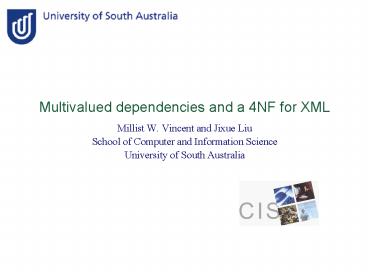Multivalued dependencies and a 4NF for XML - PowerPoint PPT Presentation
1 / 18
Title:
Multivalued dependencies and a 4NF for XML
Description:
Section Emp='e1' Project='j1'/ /Dept Dept Section Emp='e3' Project='j2'/ /Dept ... Emp. v8 'e3' A. Project 'j2' v10. Basic Definitions ... – PowerPoint PPT presentation
Number of Views:27
Avg rating:3.0/5.0
Title: Multivalued dependencies and a 4NF for XML
1
Multivalued dependencies and a 4NF for XML
- Millist W. Vincent and Jixue Liu
- School of Computer and Information Science
- University of South Australia
2
Overview
- Motivation.
- Basic Definitions.
- MVDs in XML.
- Redundancy in XML.
- Hierarchical XMVDs.
- A 4NF for XML.
- Conclusions and future research.
3
Motivation
- Large amounts of data stored in XML format.
- How to normalize XML documents to avoid
redundancy? - FDs and MVDs are the basis for normalization in
relations. - Recent research has defined functional
dependencies and a redundancy free normal form
for XML. - How to extend the approach to multivalued
dependencies in XML?
4
Multivalued Dependencies in XML
- Modeling XML Documents
- ltrootgt
- ltDeptgt
- ltSection Empe1 Projectj1/gt
- lt/Deptgt
- ltDeptgt
- ltSection Empe3 Projectj2/gt
- lt/Deptgt
- lt/rootgt
5
Basic Definitions
- Path is a sequence of labels from the root, e.g.,
- root.Dept.Section
- Path intersection e.g.,
- root.Dept.Section.Emp ? root.Dept.Section.Project
root.Dept.Section
E
root
vr
E
E
Dept
v2
Dept
v1
E
E
Section
v3
Section
v7
A
Emp
v4
A
A
A
Project
v6
Emp
v8
Project
v10
e1
j1
e3
j2
6
Basic Definitions (cont.)
- Path instances of a path. For example, a path
instance of - root.Dept.Section is vr. v1. v3
- Function Paths(q) is the set of all path
instances of path q. - Function N(root.Dept)v1, v2
- Function Nodes(v1, root.Dept.Section)v3
- Function val(v3)v3, val(v4)e1.
E
root
vr
E
E
Dept
v2
Dept
v1
E
E
Section
v3
Section
v7
A
Emp
v4
A
A
A
Project
v6
Emp
v8
Project
v10
e1
j1
e3
j2
7
XMVD Definition
- Let P be a consistent set of paths and let T
be an XML tree that conforms to P and is
complete. An XMVD is a statement of the form p
\rightarrow\rightarrow - q r where p, q and r are paths in P.
T satisfies p \rightarrow\rightarrow - q r if whenever there exists two distinct
paths path instances v _1. \cdots. - v _n and
- w_1. \cdots. w _n in Paths(q) such that
- (i) val(v_n) \neq val(w _n)
- (ii) there exists two nodes z_1, z_2, where
z_1 \in - Nodes(x_1_1, r) and z_2 \in Nodes(y_1_1,
r) such that val(z_1) - \neq val(z_2)
- (iii) there exists two nodes z_3 and z_4,
where - z_3 \in Nodes(x_1_1_1, p) and z_4 \in
Nodes(y_1_1_1, p), such that val(z_3)
val(z_4) - then
- (a) there exists a path v'_1. \cdots. v'_n in
Paths(q) such that - val(v'_n) val(v_n) and there exists a node
z'_1 in
8
XMVD Example
- root.Id.Course ??
- root.Id.Id.Teacher.S root.Id.Id.Text.S
- is satisfied.
9
XMVD Definition
- How do we know the definition of an XMVD is
correct? - NO definite answer, but in another paper we show
that for a very wide class of mappings from a
relation to XML a relation satisfies an MVD if
the XML document satisfies the XMVD. - Hence there is a natural correspondence between
MVDs in relations and XMVDs in XML.
10
XMVD Example (contd.)
- root.Project.P??root.Project.Person.Nameroot.Pr
oject.Part.Pid - is violated.
11
XMVD Example
- root.Id.Course ?? root.Id.Id.Teacher.Sroot.Id.Id.
Text.S is satisfied.
12
XMVD Example (contd.)
- root.Project.Person.Name ??Root.Project.Person.Ski
llroot.Project.P - is violated.
13
Redundancy in XML
- An XML tree has redundancy if there exists a node
such that every change of the value of the node
to a new value results in violating the MVDs. - Example Consider the tree below and XMVD
root.Id.Course? ?root.Id.Id.Teacher
root.Id.Id.Id.Text. All Teacher and Text nodes
are redundant.
14
Hieararchical XMVDs and Keys
- A set of XMVDs is said to be hierarchical if for
every XMVD p \rightarrow\rightarrow qr
Parnt(p) is a strict prefix of both q - and r. A path p is a key if N(p) contains no
duplicate values.
15
4NF for XML
- A set of hierarchical XMVDs and keys is in 4XNF
if for every p ?? qr if either of the following
conditions hold(i)q and r are both
keys(ii)p is a key and q ? r p. - Theorem If a set of XMVDs and keys is in 4XNF
then no tree which satisfies the XMVDs has
redundancy.
16
4NF Example
4NF Example
- Example Consider the set of XMVDs
root.Id.Course? ?root.Id.Id.Teacher
root.Id.Id.Id.Text. Not in 4XNF.
17
4NF Example (contd.)
- Consider the set of XMVDs root.Id.Course ??
- root.Id.Id.Teacher.S root.Id.Id.Text.S and
- root.Id.Id.Teacher is a key and
- root.Id.Id.Text is a key. 4XNF is satisfied.
18
Future Work
- Need to extend main theorem to the case of
arbitrary XMVDs. - Is 4XNF a necessary condition for no redundancy.
- XFD implication is decidable. Is XMVD implication
decidable? - Axiom system for XMVD implication?
- Polynomial time algorithm for XMVD implication?
- Interaction between XFDs and XMVDs.































